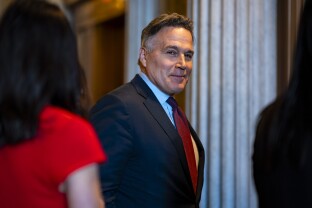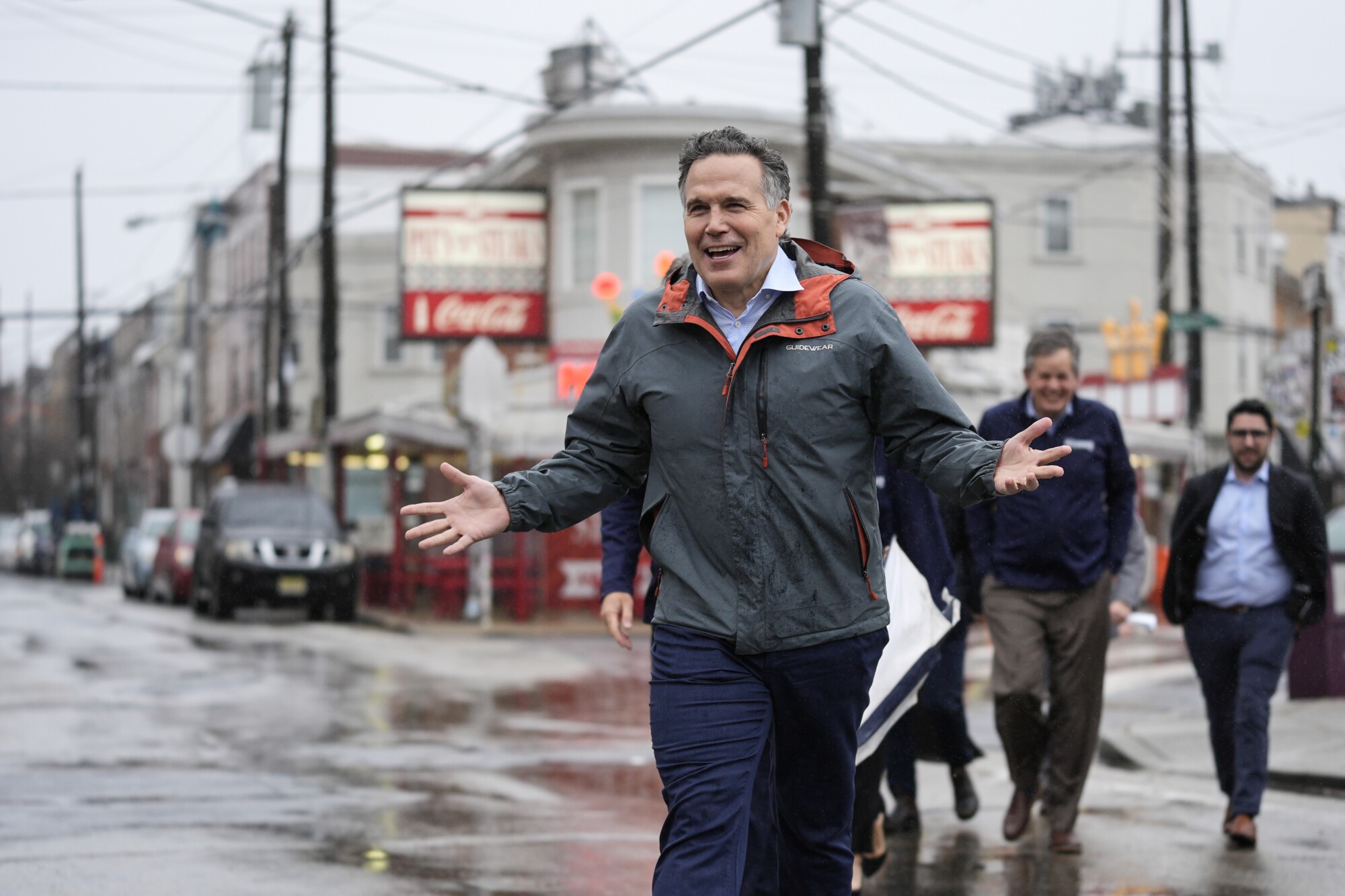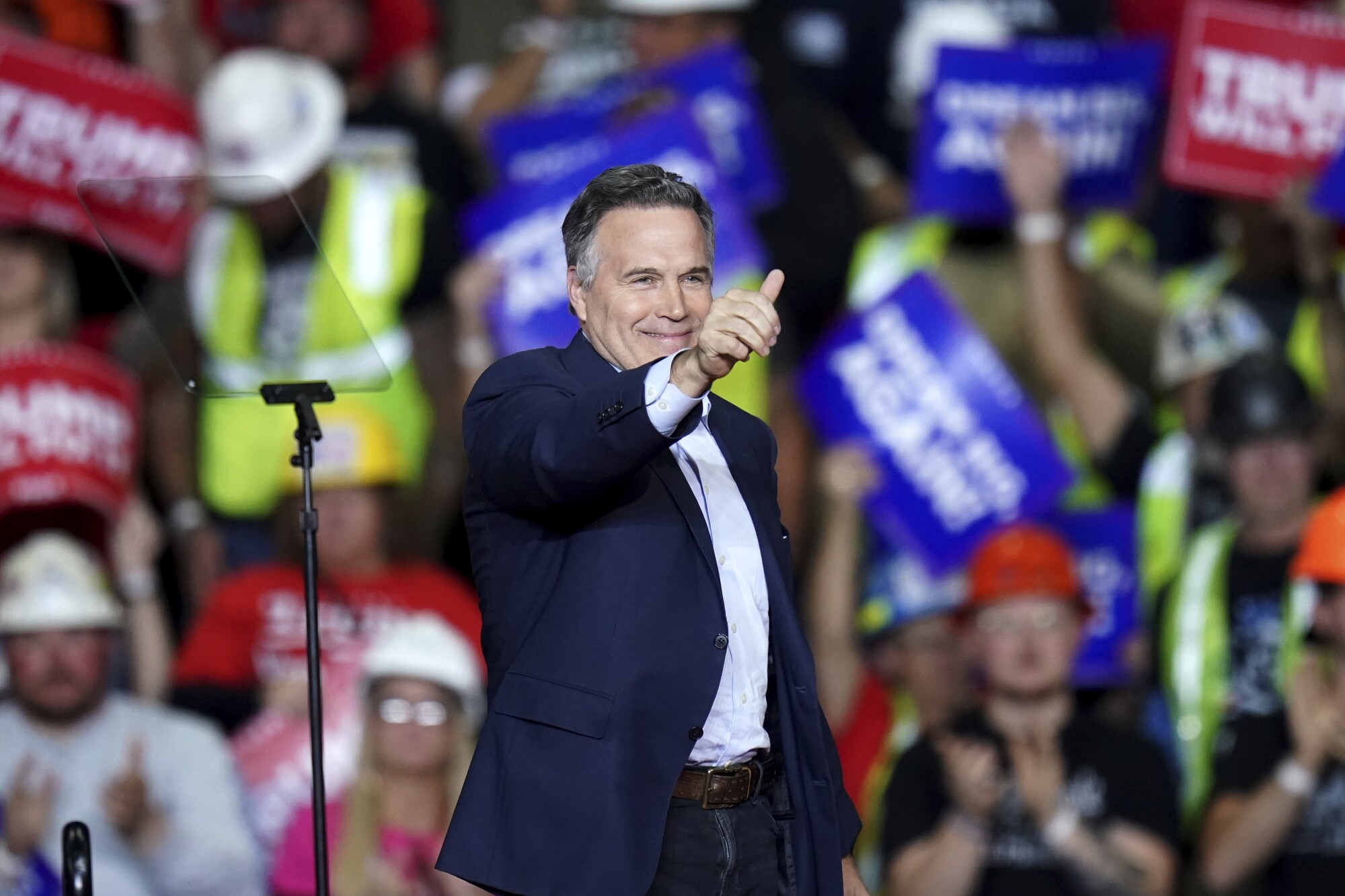A scant two weeks before the election, Dave McCormick boarded a predawn flight headed across state lines. The Pennsylvania Republican was making a last-minute trip that would eventually see him standing outside the gates of West Point before scrambling back to the state later that afternoon for a major campaign appearance with Elon Musk.
Top campaign aides would later say the impromptu travel was necessary to put the exclamation mark on a political strategy that helped him become the only Republican candidate to win a swing state Senate race this year.
For much of the campaign, McCormick’s top advisers — including Mark Harris, Brad Todd and campaign manager Matt Gruda — had been fixated on a politically disengaged group of hard-to-reach voters who supported Donald Trump but not McCormick. Even in October, many of these Trump supporters still didn’t know who McCormick was, much less planned to vote for him.
So with the window to reach unconvinced voters closing quickly, McCormick and his senior advisers made a dramatic decision: The candidate, despite a hectic schedule, would take a 5 a.m. flight from Pittsburgh to his alma mater on Oct. 20 to film a campaign ad highlighting his military service, hopeful his apolitical background would reach voters distrustful of all politicians. The visit was so hastily arranged that in the hours before the shoot, McCormick and a team of top advisers held a morning meeting in a West Point Mexican restaurant to go over the logistics and details of the process.
“It’s very unusual that close to the election to leave the state for any reason, with the potential logistical dominoes that could fall,” Harris said in an interview. “But we felt like we needed to do this to land that final message to tell voters why they needed to vote Dave.”
The ad, and the strategy behind it, worked: McCormick would win the election two weeks later, defeating Democratic Sen. Bob Casey by just 16,000 votes, succeeding where Republicans in Wisconsin, Michigan, Nevada and Arizona failed.
While McCormick advisers credit their victory to an array of factors, the most significant of them might be their effort to target, engage and turn out a tranche of the electorate inclined to back Trump but otherwise dismissive of all other candidates, including Republicans. It’s an approach veteran Republican strategists say will become an essential element of future GOP campaigns, as the party tries to replicate the president-elect’s popularity even when he’s off the ballot.
“This wasn’t like an aha moment where we realized, ‘Oh, we have a problem to fix,’” Gruda said. “We knew these were voters we needed from the outset.”
Traditionally, Democrats have been the party that benefits from politically disengaged voters, while Republicans counted on the support of voters who turn out for every primary and every general election. That the dynamic has flipped should persuade Republican strategists to retool their campaigns if they want to keep winning elections, McCormick officials say.
“There’s a religion change that needs to be in effect here,” said Gene Ulm, the campaign’s pollster. “As Republicans, we grew up with this notion that our voters turn out, that they’re the most likely to turn out. That’s not true anymore.”
Trump was the first Republican candidate to truly tap into this low-propensity coalition, Ulm added, and McCormick’s campaign was committed to following in his wake.
“It was clear for Dave McCormick that that was our path,” he said.
McCormick was the first Republican gubernatorial or Senate candidate to win in Pennsylvania since 2016 when former Sen. Pat Toomey won reelection. In that race, Toomey won partly because of his ability to distinguish himself from Trump, then running in his first presidential general election, especially in the suburbs where the GOP nominee was least popular.
But this year, Trump won Pennsylvania by 1.7 percentage points, more than double his 2016 margin in the state. Unlike Toomey, McCormick’s campaign was intent on bolstering its association with Trump.
McCormick officials are quick to say that engaging low-propensity voters wasn’t the campaign’s only reason for success. The campaign aggressively rebutted Democratic attacks on McCormick’s position on abortion rights, they say, and sought to position him as a doting father of six daughters, efforts that might have helped him outperform Trump in the suburbs of Philadelphia. They credit his doggedness on the campaign trail, including a statewide bus tour launched over the objections of some advisers and an early and aggressive TV ad campaign that let McCormick counter Democratic attacks before they sank in with voters.
Democratic critics and even some Republicans point out that Trump won Pennsylvania by a larger margin than he did other swing states like Wisconsin and Michigan, making McCormick’s task easier, and that McCormick performed worse than other Republican candidates this year in Pennsylvania, including those running for attorney general and state treasurer. Unlike other Republican hopefuls, McCormick benefited from a super PAC that spent nearly $55 million boosting his campaign and attacking Casey.
“McCormick’s money — and McCormick’s friends’ money — is why he won the race,” one Democratic strategist said.
But Casey, the scion of Pennsylvania’s most famous and well-respected political family, was supposed to be nearly unbeatable, having cruised to victory in all three of his prior Senate races. In 2012, when he managed the campaign of Casey’s Republican opponent, Harris said he was happy to have kept the margin to under double digits. (Casey won his last reelection, in 2018, by more than 13 points.)
McCormick officials knew defeating Casey wouldn’t be easy, though they believed the Democrat had yet to truly face a stern test since first winning election in 2006. And they knew, based on comprehensive studies of the electorate, that they weren’t nearly as well-known as Trump with voters who hardly paid attention to politics.
Many of those voters don’t have a college education, a demographic already favorable to Trump. In Pennsylvania, many of them were in the state’s western and central areas, away from large metropolitan centers and uninterested in the news.
“All of our research showed one of the problems was that there was this group of 20% of Trump voters who were very low politically engaged people,” Harris said. “They don’t read the news, and particularly over the summer, they don’t watch TV, they just consume very little media. They’re taking their kids to soccer, and politics isn’t important in that same way to them.”
The campaign’s challenge then was trying to reach them at all. So the campaign made it a priority for their door-to-door field program to identify and find those voters, according to Gruda. They texted them, they sent mailers to their homes and advertised on even the smallest rural radio stations.
Anytime Trump appeared in the state, the campaign made a concerted effort to make sure McCormick appeared at the kind of event that this voter bloc might actually pay attention to.
“We missed maybe one Trump rally, and there were like 20 Trump rallies in the state,” Gruda said.
But above all, the campaign identified one essential way to reach these voters: football. America’s most popular sport also drew many of these voters to their screens, so the campaign religiously bought commercial slots during college and professional games — even if it was a game featuring relatively obscure teams like an October matchup between the University of Hawaii and Boise State University.
“Even if only 10,000 people in Pennsylvania watched those random college football games, they made ripe targets for us because they were right in our demo,” Todd said.
Commercial time during Pittsburgh Steelers games was especially in demand, Todd added, saying he was willing to do without ads on local news coverage (the traditional time slot for most campaign ads) for a single spot during the NFL team’s game.
McCormick officials say their focus on those voters helped the campaign in many rural counties, especially compared to the GOP nominee’s performance against Casey in 2018. In Greene County, for instance, McCormick did 34 points better against Casey than the Democrat’s last opponent.
“Literally, that became our only priority in pretty much all of August and the start of September, how much we were closing the gap,” Harris said.
Still, even as McCormick’s advisers felt good in the final weeks of the race, their polling data and research showed that the gap between Trump’s support, or at least people considering backing the presidential candidate, remained persistent. According to Todd, one survey found that 21% of people still undecided about the presidential race hadn’t even heard of McCormick, despite months of campaigning and tens of millions of dollars spent on ads.
The aides knew they needed to make one last push, so they hatched the West Point plan. The window to film and air the ad was so tight — many campaigns want to have an ad ready to go two weeks before an election — that the campaign decided to fly McCormick out of state even before it had permits to film in the city.
“We felt like we had them on the one-yard line,” Harris said. “We just needed to push them across the finish line.”
The ad reprised a theme from one of McCormick’s first television spots, emphasizing his military service and résumé rather than policies. That simple, biographical approach would resonate with these infrequent voters, campaign officials hoped.
“It defined him as a patriot and as someone willing to do hard things,” Todd said. “We thought it validated him as an outsider whose accomplishments were not in the political sphere.”
Too often in the past, he added, Republican campaigns chased Trump-supporting voters by emphasizing his endorsement of their candidates or featuring him in an ad or two of their campaigns. But Todd said that’s a “false read” — GOP campaigns should instead communicate to these voters that they should like their candidate for the same reasons that they like Trump, whether because he’s a political outsider or an independent voice for their values.
“We just couldn’t take the chance that people could vote,” Todd said, “and not know that West Point was the seminal experience in [McCormick’s] life.”
—
Alex Roarty is a reporter at NOTUS.
Sign in
Log into your free account with your email. Don’t have one?
Check your email for a one-time code.
We sent a 4-digit code to . Enter the pin to confirm your account.
New code will be available in 1:00
Let’s try this again.
We encountered an error with the passcode sent to . Please reenter your email.




